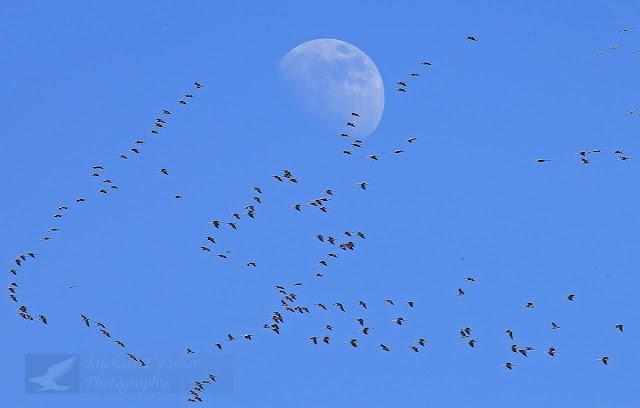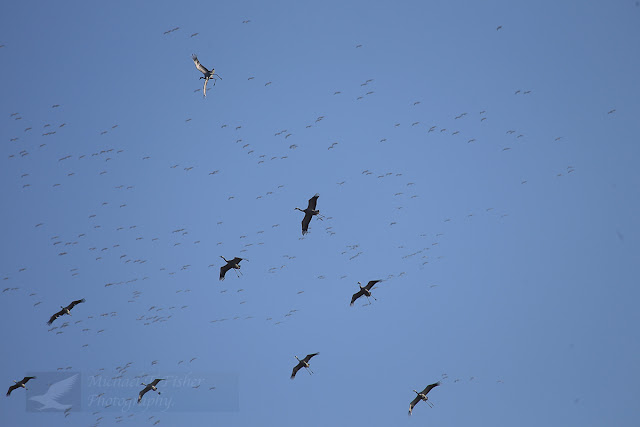One of the most enthralling wildlife experiences in Europe and the World is happening. The Crane migration is underway; they are returning to their breeding grounds north.
Their deep trumpeting calls fill the air as these magnificent birds pass overhead wave after wave.
Not long before, the unfavourable winds brought large numbers of Cranes lower, spiralling around as they sought the thermals that would convey them higher, returning them to their passage route.
At this time of the year here in the Southwest of France, it is customary to witness hundreds of Cranes a day heading North, and for us, this is usually found to be the afternoons. One day, though every year, is an extraordinary day when literally thousands of Cranes cross our skies, and this was one of those days.
With the headwinds hampering their journey, many have become tired, looking like parachutists, the first birds start to break from the ranks.
Some of these will be individual family groups that will stay together if one becomes too tired to continue.
Here on the floodplain at La Brousse, we could see them descending onto the fields between
the rivers Dronne and Brousse.
Overhead, more arrive, many seeming to make it through the now Crane jam, only to be forced back by the high winds.
They return to join the melee of what is now becoming thousands.
Cranes stand over one meter tall with long necks and legs and a wingspan of just over two meters.
They must avoid hitting each other; we observed two birds with broken legs.
By the late afternoon, it is truly a spectacle.
More birds join the mass confusion all the time. Many are struggling to land, with some birds also taking off because of their uncertainty about what to do.
The Sun starts to set across the floodplain, tinging the Cranes a pinkish red.
The Sun may have set for the day. However, this is not discouraging for the Cranes, as more arrive after dark.
The following morning, with sunshine spreading across the fields, the first birds of the day get airborne. It is still very windy, so they will likely feed rather than continue their journey.
Installed in a hedgerow, out of their sight, I wait! It was not long before a few hundred started to arrive.
The sound of their wing beats as they fly directly over my head and the excellent trumpeting calls.
An adult bird with last year's juvenile.
Another group of Cranes flew overhead, suddenly unnerving the settled group.
They are off and following.
More and more are rising from the roost, joining the food search.
This pair of adult birds look pretty splendid.
From their arrival on Sunday, they stayed with us through the following week. On Thursday, forecasters warned of Winter storm Emma passing through the area. Fortunately for us and the
Cranes, we only received some interesting daytime skies!
Thursday evening, we watched the Cranes come to roost for the last time.
On Friday and Saturday mornings, we awoke to beautiful weather in the southwest of France. The Cranes grasped this moment and headed onwards on their incredible journey.
Their deep trumpeting calls fill the air as these magnificent birds pass overhead wave after wave.
Their journey north from the winter feeding grounds was found in North Africa, Spain, Portugal, and the Landes region of France.
Not long before, the unfavourable winds brought large numbers of Cranes lower, spiralling around as they sought the thermals that would convey them higher, returning them to their passage route.
At this time of the year here in the Southwest of France, it is customary to witness hundreds of Cranes a day heading North, and for us, this is usually found to be the afternoons. One day, though every year, is an extraordinary day when literally thousands of Cranes cross our skies, and this was one of those days.
With the headwinds hampering their journey, many have become tired, looking like parachutists, the first birds start to break from the ranks.
Some of these will be individual family groups that will stay together if one becomes too tired to continue.
Battered by the strong winds, it was not long before hundreds sought a safe roost.
Here on the floodplain at La Brousse, we could see them descending onto the fields between
the rivers Dronne and Brousse.
Overhead, more arrive, many seeming to make it through the now Crane jam, only to be forced back by the high winds.
They must avoid hitting each other; we observed two birds with broken legs.
By the late afternoon, it is truly a spectacle.
More birds join the mass confusion all the time. Many are struggling to land, with some birds also taking off because of their uncertainty about what to do.
The Sun starts to set across the floodplain, tinging the Cranes a pinkish red.
The Sun may have set for the day. However, this is not discouraging for the Cranes, as more arrive after dark.
The following morning, with sunshine spreading across the fields, the first birds of the day get airborne. It is still very windy, so they will likely feed rather than continue their journey.
Installed in a hedgerow, out of their sight, I wait! It was not long before a few hundred started to arrive.
The sound of their wing beats as they fly directly over my head and the excellent trumpeting calls.
Unsure, some start to eat, while others appear alert. The ground is frozen, and the temperature is still minus four degrees in the sunshine.
An adult bird with last year's juvenile.
Another group of Cranes flew overhead, suddenly unnerving the settled group.
They are off and following.
More and more are rising from the roost, joining the food search.
I could see them settling on a far field, sensibly forming a line stretching along its crest, perfect security, with so many pairs of eyes on the lookout!
This pair of adult birds look pretty splendid.
From their arrival on Sunday, they stayed with us through the following week. On Thursday, forecasters warned of Winter storm Emma passing through the area. Fortunately for us and the
Cranes, we only received some interesting daytime skies!
Thursday evening, we watched the Cranes come to roost for the last time.
On Friday and Saturday mornings, we awoke to beautiful weather in the southwest of France. The Cranes grasped this moment and headed onwards on their incredible journey.

























No comments:
Post a Comment